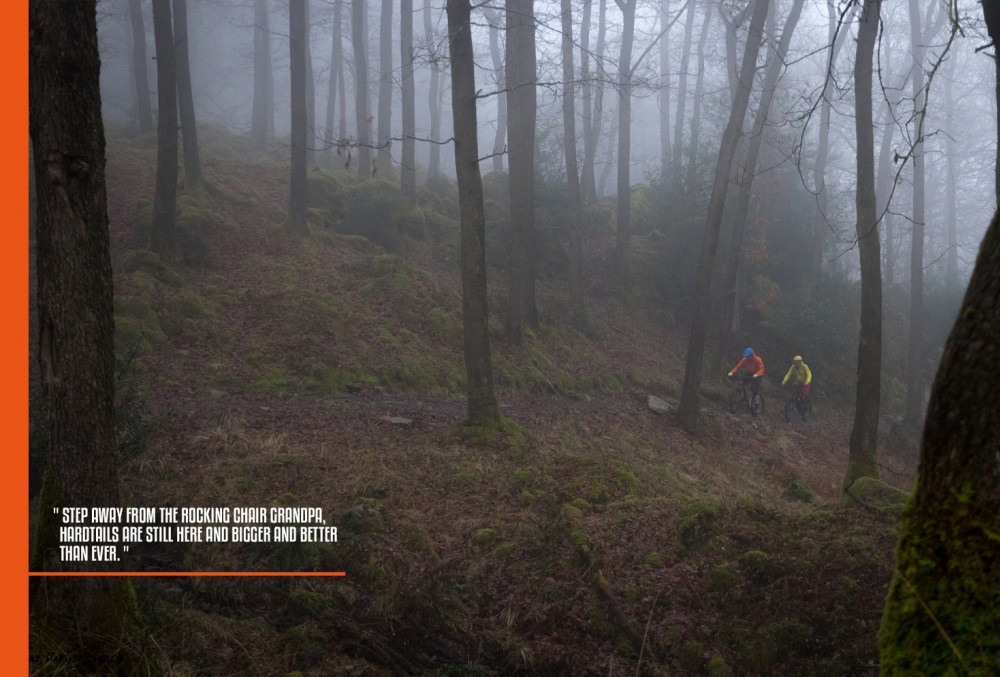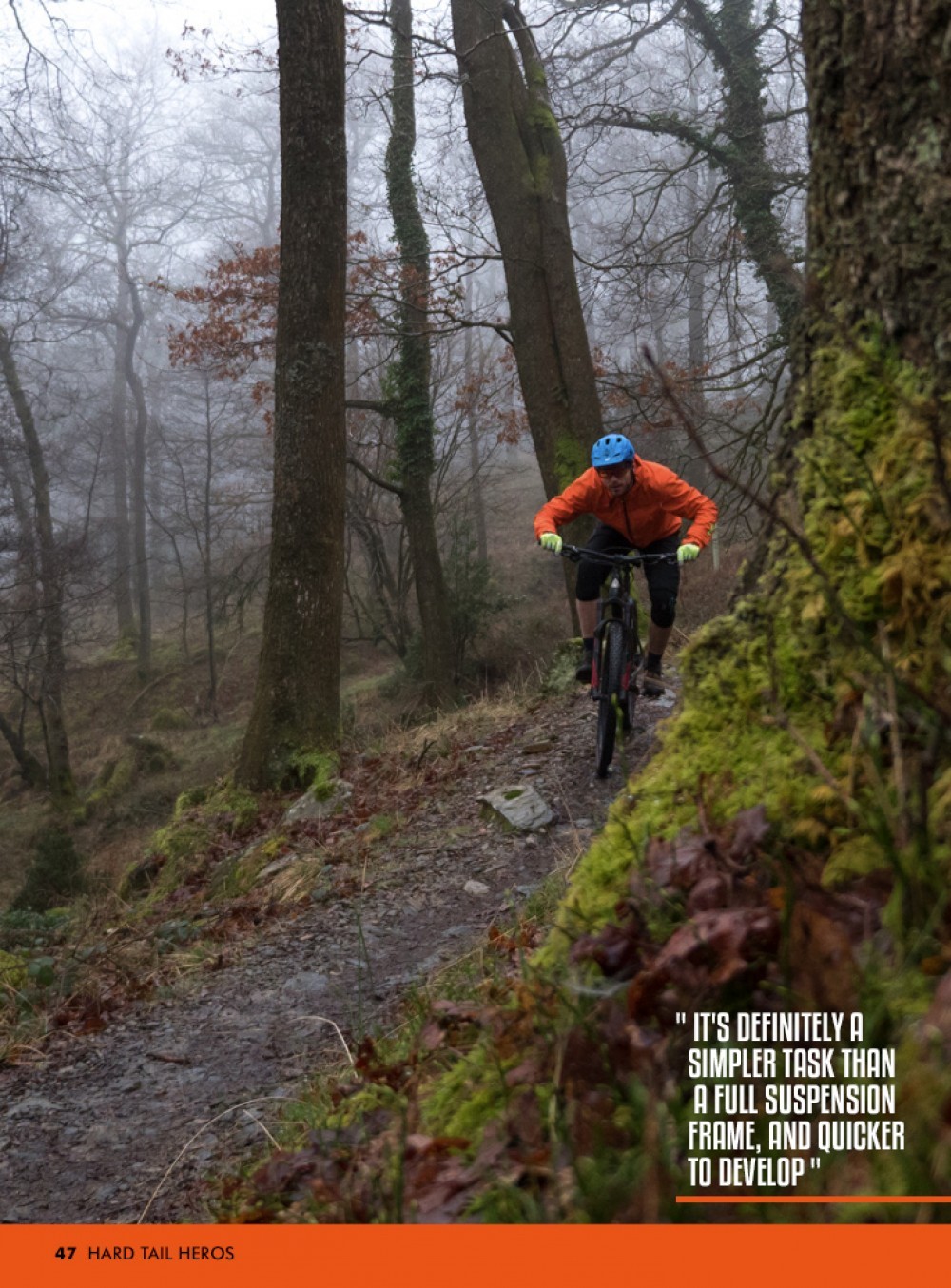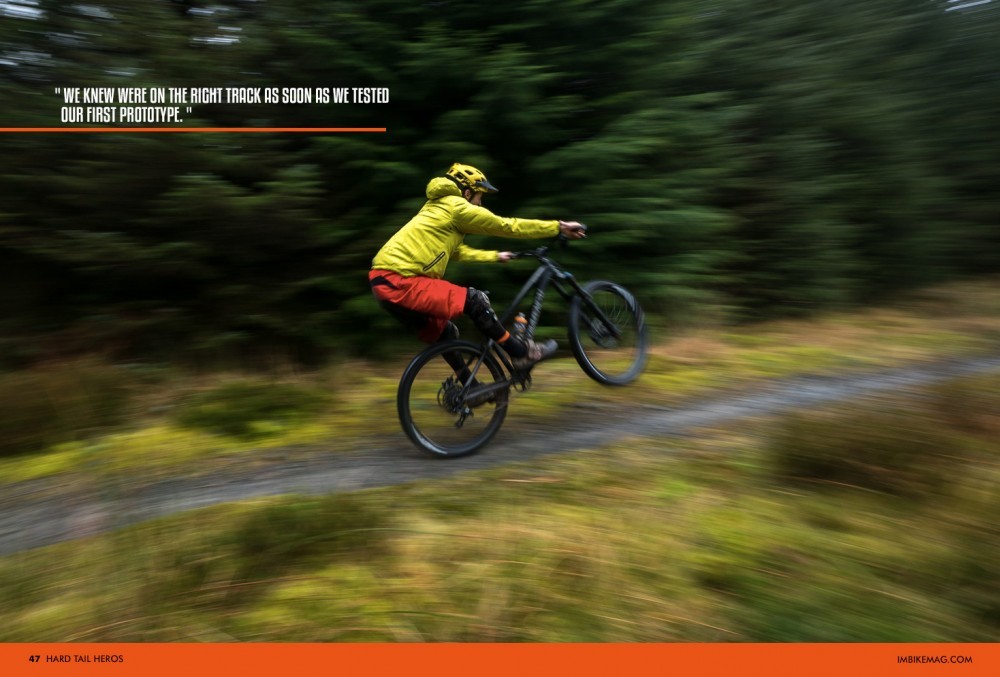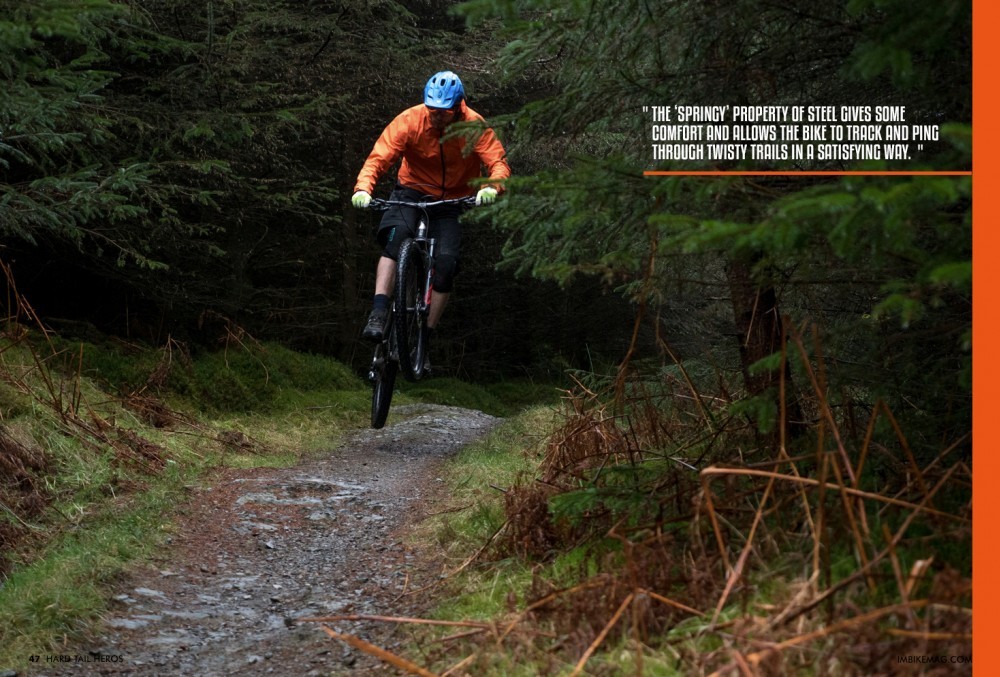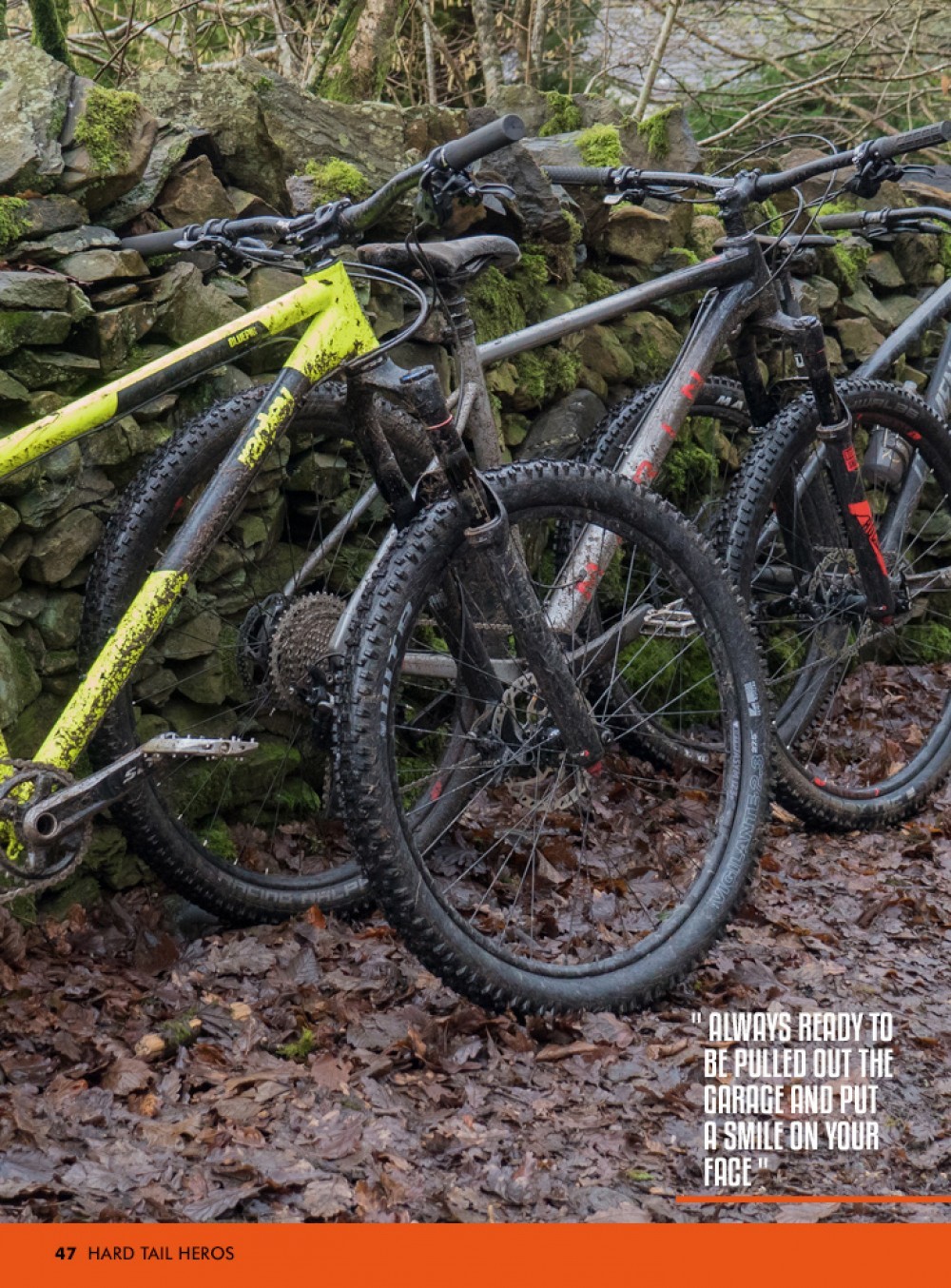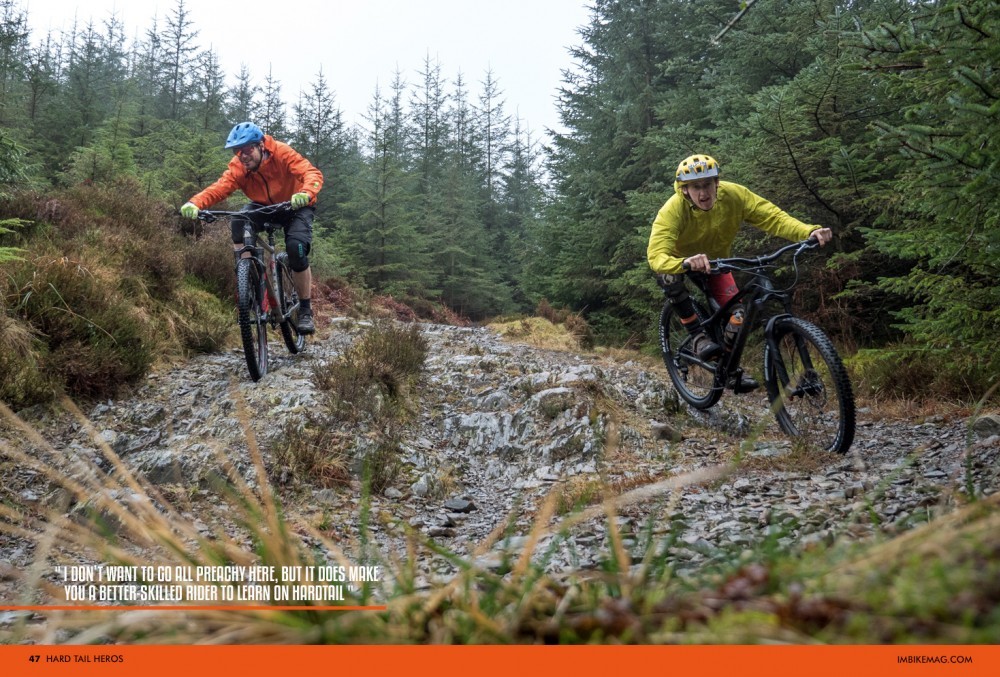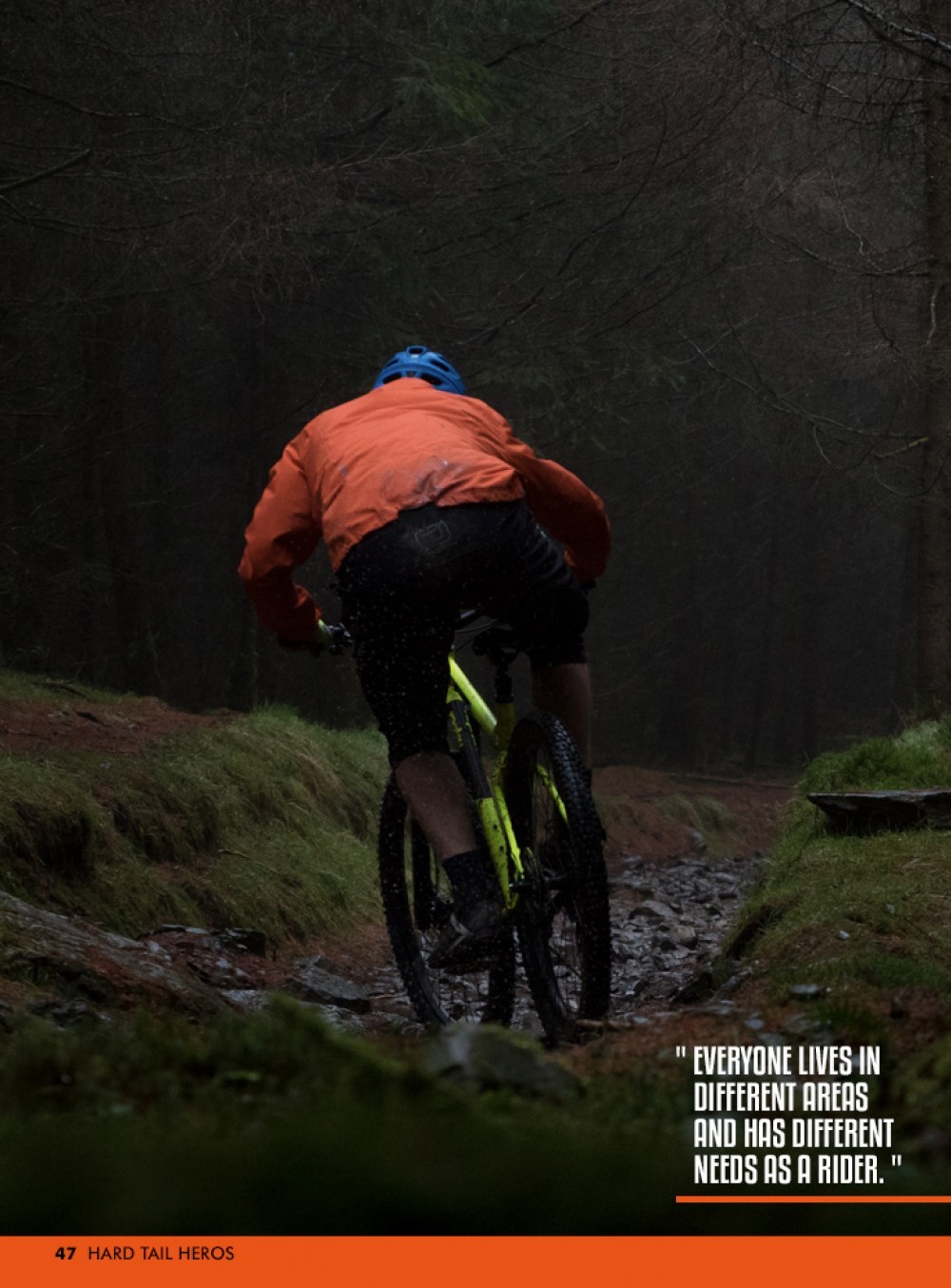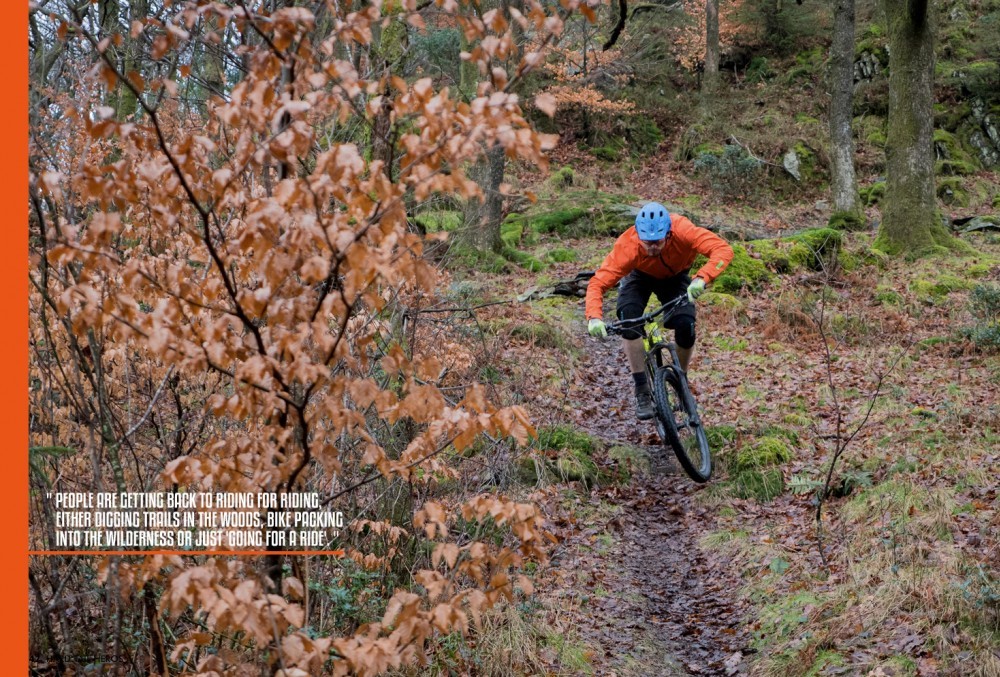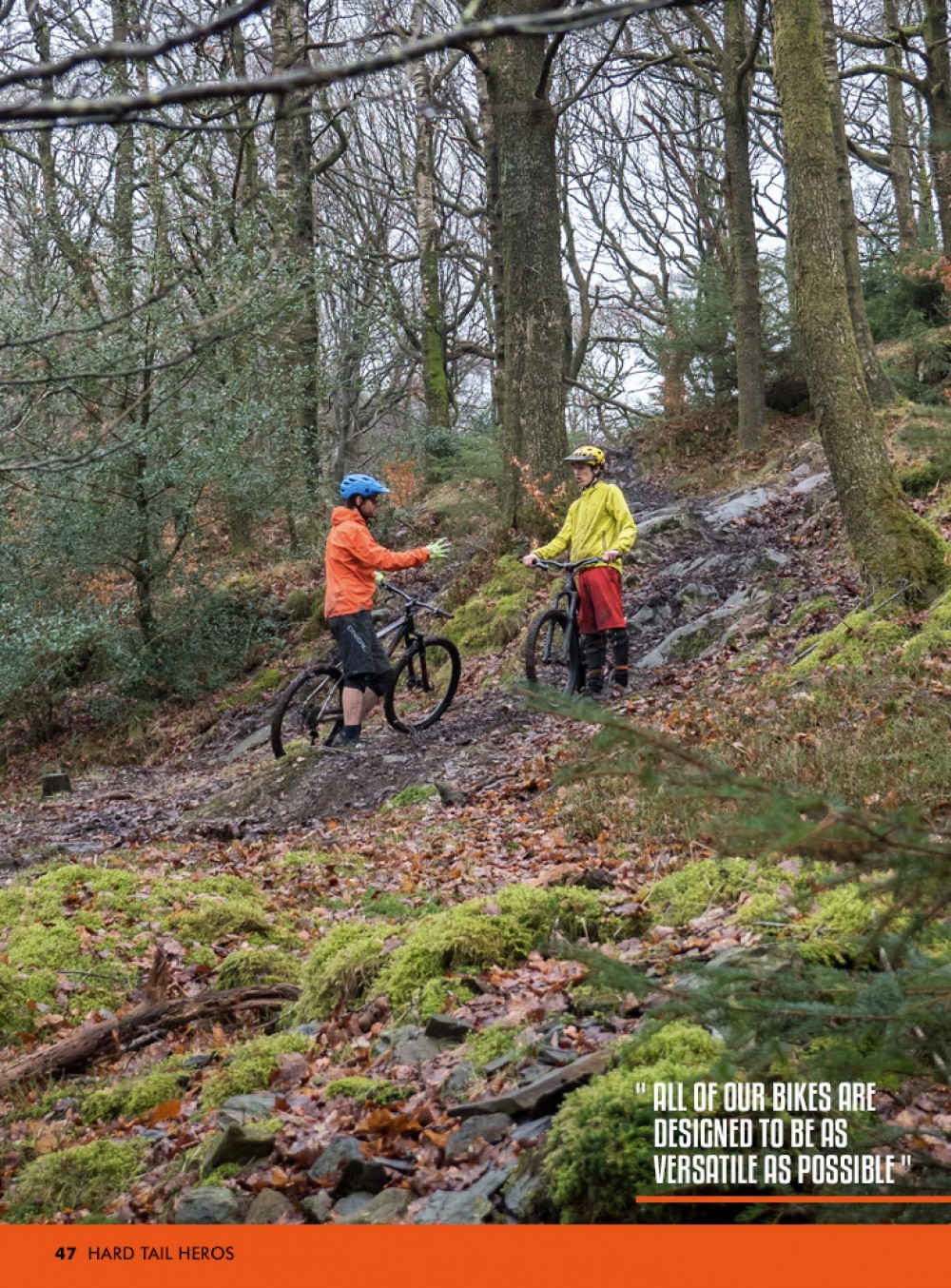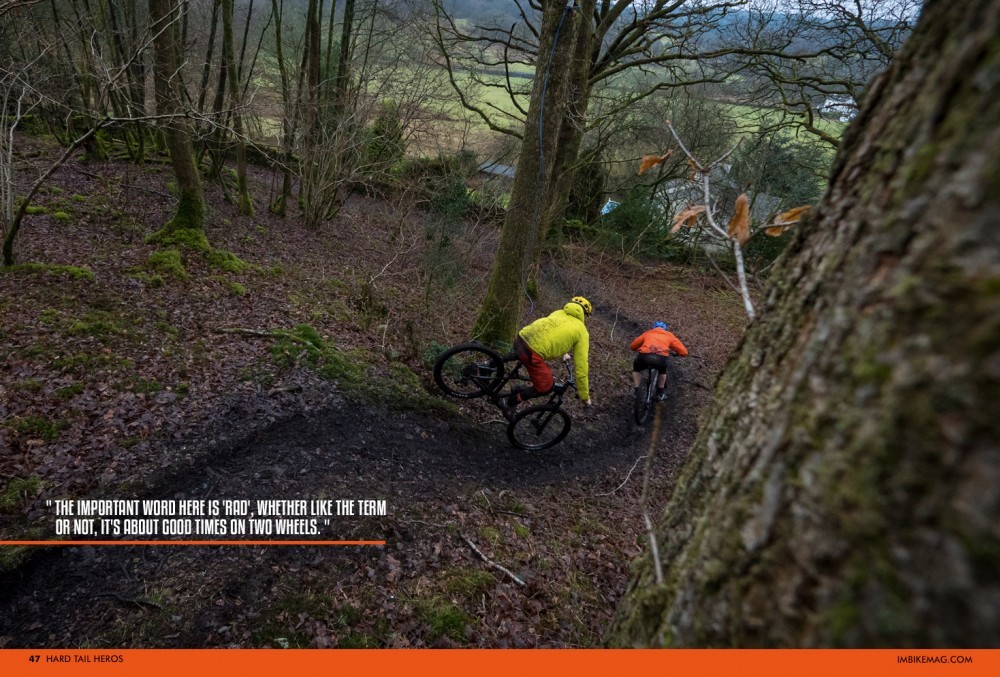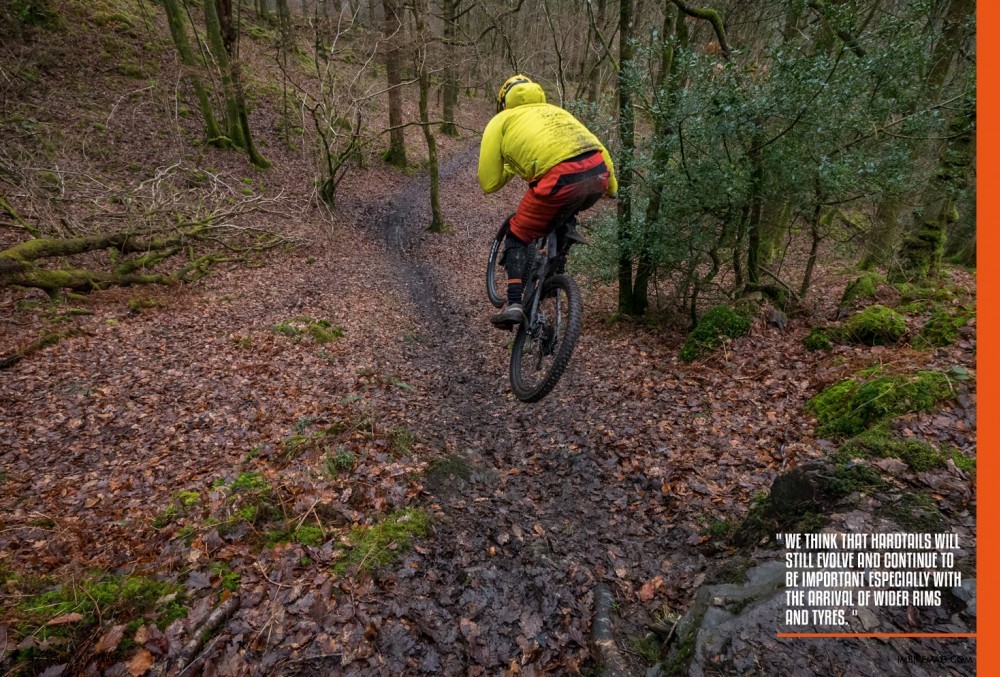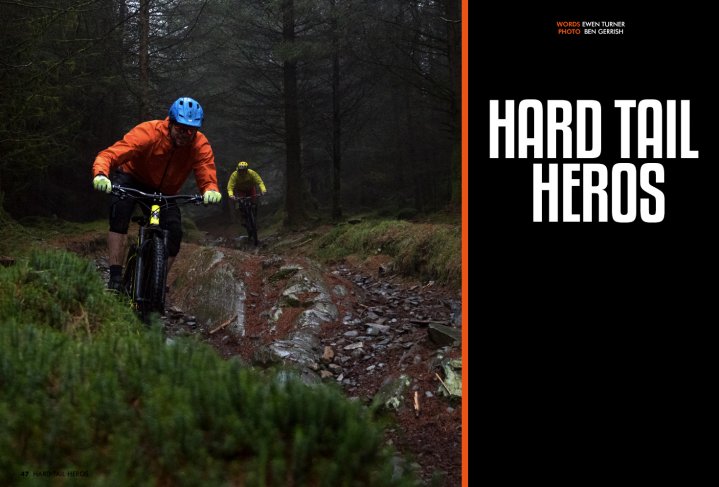
Hardtail Heroes
Issue 47 / Mon 17th Apr, 2017
Ewen Turner emerges from a wet winter of hardtail shredding, sits by the fire and reminisces about back in the day when bikes were bikes, had 400 gears, weighed as much as a cow, and never broke. He gets together with some of the big players in the hardtail world and asks if there is still room for hardtails in the modern, carbon blinged-up world of mountain biking.
Ewen Turner emerges from a wet winter of hardtail shredding, sits by the fire and reminisces about back in the day when bikes were bikes, had 400 gears, weighed as much as a cow, and never broke.
He gets together with some of the big players in the hardtail world and asks if there is still room for hardtails in the modern, carbon blinged-up world of mountain biking.
The Origin of the Species
It occurred to me recently that it is now entirely possible, and pretty likely, that there are riders out there who may not have ridden a hardtail. Those of us who started riding before the turn of the century had little option for full bounce bikes, and a rigid bike was pretty commonplace, let alone one with front suspension. I could now go misty eyed and wax lyrical about my first proper mountain bike, with its rigid steel frame, V-brakes, 21 gears, but no, this is a modern article on modern bikes. Step away from the rocking chair grandpa, hardtails are still here and bigger and better than ever.
Other than the development of the suspension fork, have hardtails really come that far from the original off-road clunkers and hack bikes that those intrepid cyclists first took off road? Essentially the diamond shape frame is the same; two wheels are still one of the few mountain bike standards and hell, we now have fewer gears than 20 years ago. It's progress, just perhaps not so obvious to the casual observer. Damian Mason of DMR knows a thing or tow about hardtails, being the 'D' in DMR and responsible for some iconic machines. 'I think Hardtails are in the British DNA, ‘we (the British)’ did refine the design of the original bicycle with James Starley’s (Born in Sussex about 5 miles from our office!) ‘Safety Bicycle’ design in 1877 and it's still in that form today pretty much.'
So while technology has moved on, there are those of us who still like to cherry pick our technology, mixing the modern with the traditional. Dropper posts, air suspension, one-by drivetrains, all strapped onto a steel hardtail to create a thoroughly modern machine with a nod to the past, when riding was real, or something like that...
The Current Evolution
So what of this new breed of hardtails? Are they really new, or just a continuation of the development of the humble bike frame? How difficult is it to develop a modern hardtail, surely it has all been worked out? Given that DMR has just produced a new full suspension bike (The Sled), I ask Damian about the development of a hardtail over a full suspension frame, 'It's definitely a simpler task than a full suspension frame, and quicker to develop. Working with steel (or aluminium) means we can sample and adjust the design relatively quickly. We always go through a cycle of ride-testing and refinement with our frames'.
The DMR Trailstar is a redesigned classic, undoubtedly a challenging makeover for an iconic machine? Damian's approach to the new Trailstar was quite an ‘open’ style design, intended to be built up and used for all sorts of things and not be too niche. It's all about balance and goes on to explain, 'getting the geometry and componentry choice fit right, etc. is tricky to allow this work without too much compromise'. The argument of versatility regularly comes from the hardtail rider, and this is backed up by DMR, 'We have people who race very competitively at Four Cross on it, others race hardtail downhill, most use it as a trail bike. Making a good all rounder is something a hardtail can still do well – it’s much harder to do that with a full suss bike design for sure.'
One brand that represents modern hardcore hardtails better than any is Ragley, born in 2009 they have always focussed their efforts on hardtails to great acclaim. Steven Jamieson is a man who understands the winning formula, and it turns out their bikes take more than a nod from modern trail bikes. 'The blueprint for these came from looking at modern aggressive full suspension trail bike geometry when sagged. We wanted to emulate the way that these bikes ride, but without the suspension on the rear,' Steve explains. This wasn't just based on a bit of maths, 'We knew were on the right track as soon as we tested our first prototype. Revision after revision just got better and better until you have what is on sale today'. It would seem that modern hardtails are taking a few leaves from the enduro book of geometry numbers, bringing head angles back to somewhere around 64 degrees, lengthening reach numbers and dropping bottom brackets. Frames may look not too different from a classic bike from 30 years ago, but I guarantee they ride a lot better.
And what about steel? I hear you shout, nearly spilling your flat white and getting froth on your moustache! With consumers falling over themselves to get hold of the latest carbon frames, there are still bikes being welded out of metal, and not just aluminium, but that chromoly stuff. The 'real stuff'. DMR, a brand built of steel, do they feel it is still a relevant material in the world of carbon? 'Yes! We think so; steel is a good material for a hardtail for its ride quality and toughness. The ‘springy’ property of steel gives some comfort and allows the bike to track and ping through twisty trails in a satisfying way. It's difficult to describe in text, but if you’ve owned a steel bike you’ll know what I mean'.
For Ragley, starting in 2009, that was a tough time to be bringing out steel hardtails amidst the sea of full suss bikes. Can these bikes cut it against the trail bikes? Steven thinks so, 'In most situations and in the hands of the right rider, a modern steel hardtail can be just as fast as a full suspension bike. There is nothing more satisfying than being just as fast as your mates that on full sussers. As you are directly connected to the trail underneath, there is better feedback, and it feels more natural on a hardtail.'
The blueprint is there, a modern hardtail needs to take some of that trail/enduro hype and be long, low and slack, and probably be made out of a material that works, and doesn't cost the earth, both literally and figurative. These bikes aren't attempting to win cross country medals; it's all about hitting trails hard and putting smiles on faces, and being able to do that repeatedly without buying shares in your local bike shop.
What's the point?
Having spent a winter on hardtails, I know why I love them, it's the direct connection to the trail, taking every hit with your legs and feeling every undulation beneath the tyres. It's about being able to pump the backside of every roller-shaped trail obstacle and always know where the back end is tracking, or not... A hardtail is a reliable steed, always ready to be pulled out the garage and put a smile on your face, eschewing the many knobs and buttons, just grab and go.
So why would anyone buy a hardtail? With so many brands offering full-suspension bikes at lower and lower prices, why not get more bounce to the ounce and smooth out the ride? Commencal has been keeping it real for some time now and who else to extol the virtues of the rigid rear than the man himself, Max Commencal, does he still feel they can cut it? 'We've always said that in terms of budget, it is better to buy a good hardtail than a bad full-suspension bike. That sums up our philosophy with this bike, and that's why we’ve been giving it special treatment for many years. There is a diverse interest in this category of bikes, ranging from the complete beginner to the very experienced rider, everyone for their different reasons.'
A bike for the masses, at a price that many might be able to afford. The spec on a hardtail will always be better than a full suspension equivalent, but what about ride feel? And will they make us better riders? Many riders would agree, and Damian from DMR certainly thinks so, telling me straight, 'I don’t want to go all preachy here, but it does make you a better-skilled rider to learn on hardtail, you read the terrain better, pick the best line, pump the humps and bumps to keep your speed, etc..' And the direct connection to the trail? What does he think of that? 'You get a lot of ‘feedback’ on a hardtail; it's more direct, predictable and immediate which does make it more rewarding in a way. It makes for a fun singletrack or ‘woods’ bike I think, it has its place for sure.' You'd think he might be pretty anti-suspension, but for a man who recently released 'The Sled' he still has plenty of room in his life for a big bike concluding, 'Full suss bikes are awesome as well, just in a different way, they certainly don’t make hardtails irrelevant.'
Over the Atlantic, Marin is quietly and strategically working their way through their range, starting with the hardtails with several new models out this year with classic looks, but futuristic handling capabilities. With hardtail and full suspension bikes now occupying the same price points and competing for our pocket money, are trail focussed hardtails still relevant in modern mountain biking? Matt Cipes is the mastermind behind the shift at Marin, 'Different folks, different strokes. At the end of the day, everyone lives in different areas and has different needs as a rider. There will always be a place for both hardtail and full suss rigs in the global market.'
Interestingly Matt feels a shift in the attitudes of riders, 'There is a big change in the way people are riding. It is much less cross-country oriented and well, more what I like to call soul riding. The trail bike hardtail suits this evolution of the mountain bike and if the trails aren't too nasty they are a blast to ride on a hardtail'. This shift in riding style is perhaps the counter culture to the enduro boom that has been everywhere in mountain biking recently, but that boom is over, people are getting back to riding for riding, either digging trails in the woods, bike packing into the wilderness or just 'going for a ride'. Hardtails work for these folks, no marketing hype, just a solid, reliable and fun bicycle.
So, hardtails are good for the soul, potentially cheaper, more reliable and make you a better rider. Does this match up with the wise words of Max Commencal? 'When it comes to those with a lower ability level, the advantages are numerous. Having a lighter, more manageable bike and of course at an equally fair price, with better forks and wheels is a definite bonus over having a poor quality full suspension bike'. Max goes on to explain it's not just beginners who can benefit, 'For more experienced riders, a hardtail is often their 2nd or 3rd bike in the garage. It may be used as part of a training program/pedalling or for pump track for example. For downhillers, a hardtail bike is more demanding and is less forgiving. This allows for technical and physical progression before taking those skills back to the DH bike'.
A Peculiarly British Thing?
We've heard from brands from the UK, Europe and the States, but is this hardcore/trail/fun (delete as appropriate) hardtail thing a weirdly British thing? Or just for places with terrible weather and quirky riders who shun technology for something perceived to be more real?
Ragley know a thing or two about the minds of hardtail riders, specifically in the UK, why does Steven Jamieson think that is? 'Maybe it's because a lot of the UK is relatively flat with limited access to proper big hills. The versatility of a hardtail in these situations makes a lot of sense as people can ride virtually any riding discipline, all on one bike! He goes on to add that it may just be 'because everyone grew up riding Azonic DS1’s and Spooky Bandwagons back in the day. By now the idea of life without a hardcore hardtail to hand just seems strange!' Like Damian mentioned, perhaps it's in the DNA.
Do American riders get the whole 'hardcore/fun hardtail' thing? Marin's hardtails aren't wildly extreme but they are certainly a bike you can shred on, so what does Matt Cipes think? 'Oh, heck yea! We get it, but I do feel that USA media can either portray hardtails in more of an XC light or only focus on full suss bikes. I have a couple of buddies who regularly pull out a 66-degree steel 29er HT and crush really steep, nasty trails. These riders are more few and far between than what you see in the UK, but if you look for it in the USA, you will see it.'
What about the rest of Europe, where the general idea of a hardtail is a lightweight XC bike, why do Commencal think differently? 'This general idea in Europe can also apply to full-suspension bikes, and our range is almost exclusively gravity orientated. It's simple really, the descent is what gets the adrenaline pumping' says Max, 'Obviously, all of our bikes are designed to be as versatile as possible but if there is a criterion on which we make no concessions, it has to be the smile that going downhill can provide on a good bike. So when we started working on our first hardtails, we wanted them to perform first and foremost, from this point of view'. This clear focus on priorities it what gives brands like Commencal its identity throughout the range and a loyal following of customers and riders.
The Future
The future is looking pretty bright for the hardtail riders of the world, with plenty of choices and forward thinking brands pushing the development of their bikes. With enduro and downhill races in the UK regularly having hardtail categories, it's clear there are plenty of folks out there wanting to ride and race rigid frames.
What of the future for brands, will we see hardtails gradually sidelined in favour of trickle-down technology from above? In ten years time will those new to mountain biking be swinging a leg over a carbon 160mm bike with change from $1000? Marin don't think so, 'I think HTs will always have a place in this world and Marin will continue to do our best to make rad ones to rip on' says Matt Cipes, and the important word here is 'rad', whether like the term or not, it's about good times on two wheels. 'Marin feels that mountain bikes are vehicles for fun and adventure. A hardtail can be many things to many people, and Marin wants to deliver trail hardtails that live up to the legend of the mountain bike'.
With DMR sneakily dropping a new 160mm bike this year, surely there is a temptation for Ragley to get on board the bounce-train? 'Yes, we had some prototype Full Suspension bikes back in 2012. They never made it to production, though. Going forward we would never say never, but if we were to do it, we would want it to be something really special. Watch this space!'
I don't really need to ask Commencal, as a brand so well rooted in gravity riding, they are bound to be pushing hardtails for the foreseeable future. Max tells me, 'We think that hardtails will still evolve and continue to be important especially with the arrival of wider rims and tyres. These factors will eliminate the most obvious disadvantage of this type of bike, discomfort! Furthermore, it also allows the bike to grip better while cornering and braking. Good news for beginners and experts alike'. Good news too as he tells me, 'We are currently working on a new platform that will replace the current Meta HT AM which we’ll be able to say more about in a few months'.
Thanks to Damian Mason (DMR), Matt Cipes (Marin), Max Commencal (Commencal) and Steven Jamieson (Ragley) for their input and helping me fly the flag for hardtails across the globe!
Videos
By Ewen Turner
Ewen Turner is a self-confessed bike geek from Kendal in the Lake District of England. He runs a coaching and guiding business up there and has a plethora of knowledge about bikes with an analytical approach to testing. His passion for bicycles is infectious, and he’s a ripper on the trails who prefers to fit his working life around his time on the bike.



